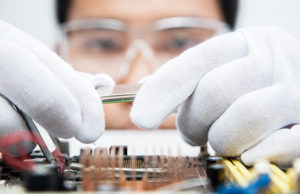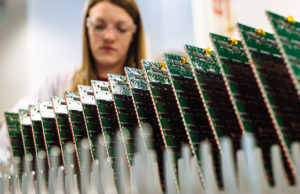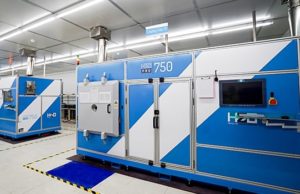Conformal Coating Application Process
Nestled within our turnkey solution, HZO has developed processes to effectively apply superior protection in the forms of conformal coating and nano coating technology to the electronic components important to your bottom line. We’ve perfected our conformal coating application processes to the point where we can offer both onsite and off-site production, can seamlessly integrate our coating processes directly into your manufacturing processes, operate at any scale, and can do so at a price point that meets the most demanding expectations.
We work closely with original equipment manufacturers (OEMs) to optimize the design for coating effectiveness, relying on our different conformal coatings types, utilizing the diversity of materials supported, combined with coating equipment designed and built by HZO, and finally drawing on the experience and expertise of our award-winning scientist, technologist, and engineers.
Learn How Our Coating Process Can Work For You
Chemical Vapor Deposition (CVD)
Before we dive into the actual conformal coating process, it’s critical to know how our coatings are applied effectively in the first place because there are many different ways that coatings can be applied. Some common application methods you may have heard of include brushing, spray coatings, encapsulation, conformal coating dipping, adhesive solutions, moisture curing and chemical vapor deposition. HZO prides itself on using the chemical vapor deposition (CVD) process to apply our different coating solutions.
Why? We believe this process is the best as it allows a truly uniform conformal coating thickness to be placed on the desired surface – penetrating into the hardest to reach crevices – thanks to the vapor form the coatings take when applied.
With the CVD application process, you’ll find that HZO’s coatings:
- Are applied everywhere.
- Aren’t heated enough to cause stress or harm to the printed circuit board assembly (PCBA).
- Provide even coverage regardless of where the coating lands, for the entire space of the PCBA.
- Can be successfully used with any type of conformal coating.
- Will never succumb to conformal coating defects.
- Provide a uniform coating thickness.
Our Conformal Coating Process Step-By-Step
1. Pre-production
We don’t leave anything to chance, even in pre-production.
Planning – Coating Selection
All great projects begin with a great plan. Before production, you would have sat down with our specialized engineers to outline the details of your particular project, determining:
- What level of protection is needed? I.e., Splash resistant? Sweatproof? Submersible? Abrasion-resistant? Solvent resistance? Corrosion resistance? etc.
- Which coating selection is best for your product?
- If there is a specific temperature range to work with?
- What electronic components need to be protected? What doesn’t?
- What price point are we trying to hit?
Thankfully, HZO likely has a solution to meet your specific coating criteria with experience to ensure quality and success. We can provide a conformal coating type for almost any application. Once a plan has been made and testing is complete, it’s time to execute.
Find Out Which Coating is Best for You
Masking (Optional)
The great benefit of Chemical Vapor Deposition (CVD) is that it allows the coating vapor to go everywhere. The tricky part about CVD is that – it allows the coating vapor to adhere to any uncovered surfaces, whether we want it to or not. This includes electronic components you don’t want to be coated. That’s where masking products comes in.
What is Masking?
Masking is the process of physically covering the areas of a PCBA or component where you don’t want a coating to be applied. This may include screens, sensors, lenses, connectors, and more whose functionality may be hampered with a coating.
Depending on the coating solution selected, you may not even need masking as many of our nano coatings are thin enough to allow connect-through as well as not interfere with sensitive electronic components.
If masking is required for more robust coatings, such as Parylene, take confidence in the fact that HZO is a leading expert when it comes to masking. Much of our intellectual property is based in innovative materials and processes designed to streamline the masking process, ensuring your production is on time, on budget with quality assured.
We can meet your production and budget needs with solutions for:
- Manual masking
- Semi-automated masking
- Seamless automated masking
Many of the above-proven masking products and solutions are not found anywhere else in manufacturing, giving you the confidence that HZO has invested in your bottom line in terms of efficiency, quality and throughput.
2. Production
By the time you get here, things are already moving smoothly.
Coating By Machine
Once your PCBAs or other electrical components have completed the masking process (if applicable) during pre-production, your products are now ready to be coated within our large, industry-first square coating chambers. The units are loaded onto coating trays and placed into racks inside the coating chamber where our technicians will apply the coatings. HZO makes full use of our square-shaped chambers with trays that hold hundreds of different rack-loading configurations, depending on the size and the width of the products to be coated. Our coating machines were designed from the ground up to specialize in mass production and it’s possible for us to easily scale up to coating hundreds or thousands or even millions of electrical components a day.
At this point, the actual coating process commences. Depending on the selected coating material, a different process takes place within the respective coating chamber.
Single Material Coating Applications
Take a look at our single material coating applications.
Parylene coatings
For Parylene coating, the conformal coating raw material (in powder form) is added to a vaporizer and sublimed from a solid to a vapor form. From this point, the chemicals are heated to a just high enough temperature in a pyrolyzer, which “cracks” the raw material into an activated monomer.
At room temperature in the coating chamber, vapor forms a uniform, thin-film polymer barrier around the electrical components being coated. Because of its vapor form, the gas is able to penetrate layers deep, protecting areas not even visible in complex PCBAs.
Parylene coating acts like a literal shield around the components, not allowing moisture, corrosive gas, salts, sticky beverages, sweat, and more to get through.
Plasma-Applied Nano Coatings
For plasma-applied nano coatings, actual plasma (the 4th state of matter) is combined with fluorocarbon gases to create a vapor inside the coating chamber. This vapor creates a fine-tuned nano coating on the PCBAs or components inside. When finished, the PCBAs have a highly dense and pinhole-free hydrophobic top layer. Water and other moisture will bead up and roll off the surface.
Plasma-applied nano coatings also have the ability to protect from salt spray, humidity, condensation, limited water immersion, noxious or corrosive gasses, and solvent splashes, spills, or immersion.
Plasma-Enhanced Parylene
Not one to silo technology, HZO has developed a process of utilizing plasma within the Parylene application process, leaving the Parylene “enhanced” without actually adding plasma to the Parylene. This new coating technology has the potential to introduce benefits including:
- Less expensive materials
- Faster deposition
- New properties
Multi-layer Material Coating Applications
Why settle for one coating layer? HZO can deposit specific materials on top of one another, the result being unique, strong, and long-lasting coatings that meet the protection needs of your products where other solutions may fall short. This is a new and exciting direction for HZO with multiple projects in development for our Spectrum of Protection™.
Atomic Layer Deposition (ALD)
Similar to CVD, HZO utilizes a process called Atomic Layer Deposition (ALD). Instead of applying one coating in a vapor form, ALD enables HZO to apply multiple layers of robust materials including metals and ceramics. ALD coats provide significant coverage for miniature to microscopic components.
There are two types of conformal coating application methods/processes for the atomic layer deposition process: stationary and rotary.
- Stationary Method:
The stationary method involves injecting one material at a time into the coating chamber, waiting for it to attach itself to the component to be coated, then purging the remaining residual from the chamber. A second material is then added to the chamber to cause a chemical reaction to the first one. This process is repeated with each additional layer of material until the desired protection is complete.
- Rotary Method:
After the material layer is applied, the rotary method uses a spinning action to separate the precursor formation.
PE-ALD Application Process
Just like plasma-enhanced Parylene, plasma can be used to enhance the ALD coating process. This could mean achieving the “just right” application temperature faster and with less energy while providing a higher speed of coating and providing more options for your waterproofing and protection needs.
Hybrid Coatings
Multi-layer coatings can also be defined as “hybrid coatings.” Hybrid coatings are coatings that are comprised of more than one type of conformal coating material – physically layered upon each other. Each layer of material is different, kind of like a lasagna!
Given the many unique coating attributes generated, hybrid coatings allow for far more options when it comes to picking the solution you need to do the right job.
The hybrid application process involves applying different layers of thin-film coatings on top of each other for specialized and customized protection capabilities.
3. Post-Production
Even though you’re through production, we’re still not quite finished with our magic.
Demasking
Once the coating process is complete, the printed circuit boards (PCBAs) then go through a process of demasking, which is essentially just removing the masking that was strategically placed in the pre-production process. Demasking can be done by hand or via automation.
Regarding demasking, HZO offers:
- Manual demasking
- Semi-automated demasking
- Seamless automated demasking
Quality Assurance
Quality Assurance is also done during the post-production phase. Quality assurance may be done visually with or without the help of our automated equipment. Our coating machines are calibrated and tested on a regular basis to guarantee expected and measurable results each time components go through the coating process.
HZO’s coating process is one of a kind. With proven and diverse solutions, you’re able to select a conformal coating that meets the protection requirements of your product while knowing it will be applied effectively, accurately, and at your specified throughput.
Reach out for to see how else we can help you!




